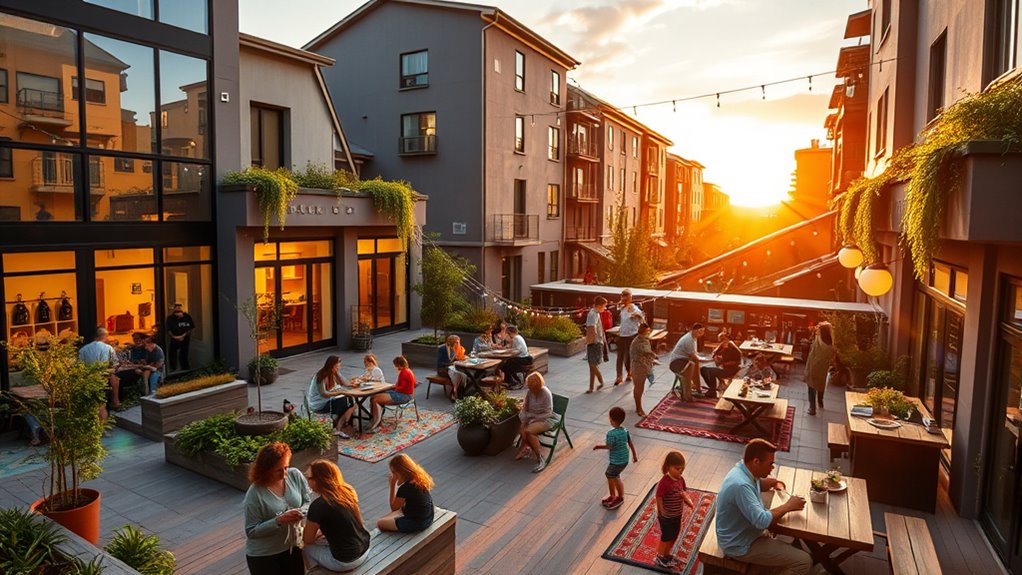Co-housing is shaping up to be the future of extended family living, blending private spaces with shared communal areas like gardens and kitchens to foster strong bonds. It offers economic benefits by reducing costs and promotes sustainability with energy-efficient design and resource sharing. Socially, it encourages cooperation, respect, and community involvement. As zoning laws evolve and successful examples emerge globally, understanding these trends can help you imagine a harmonious, resilient living environment—if you stay curious, more details await.
Key Takeaways
- Co-housing combines private living spaces with shared communal areas to foster community and support intergenerational living.
- It emphasizes sustainability, energy efficiency, and shared resources, reducing costs and environmental impact.
- Designed to promote social interaction, cooperation, and mutual responsibilities among residents.
- Challenges include privacy concerns and legal regulations, requiring clear boundaries and thorough planning.
- The future of co-housing focuses on cultural diversity, resilience, and strengthening community bonds for sustainable living.
Defining Co-Housing and Its Origins

Co-housing is an intentional living arrangement where residents share common spaces and amenities while maintaining private homes. Its origins trace back to the 1960s in Denmark, influenced by a desire for community and sustainable living. The concept evolved from historical origins rooted in cooperative housing movements and collective living practices across various cultures. Cultural influences have shaped co-housing‘s development worldwide, blending communal values with modern design. In Scandinavia, it emerged as a response to increasing urbanization and social disconnect, emphasizing collaboration and shared responsibilities. Over time, these ideas spread to North America and beyond, adapting to local social needs. Today, co-housing reflects a blend of historical cooperative ideals and contemporary cultural influences that prioritize community, sustainability, and mutual support. Additionally, the emphasis on high-density living solutions facilitates more efficient use of space and resources, further supporting sustainable community development.
Key Features of Co-Housing Communities
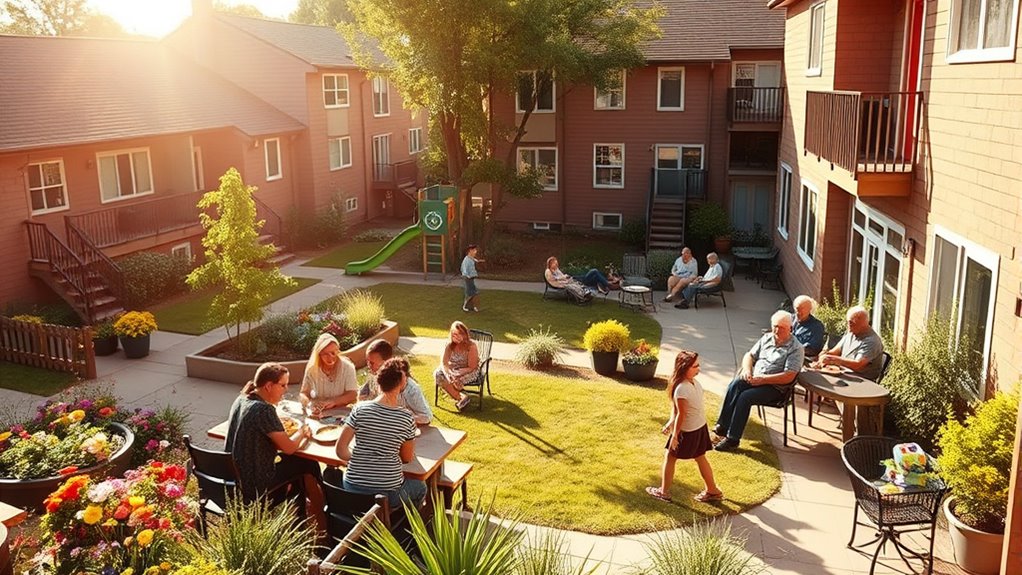
One of the defining characteristics of co-housing communities is the balance between private living spaces and shared common areas. You have your own apartment amenities, such as fully equipped kitchens and private bathrooms, ensuring comfort and privacy. At the same time, you share communal spaces like kitchens, gardens, and recreational areas, fostering interaction and cooperation. The architectural styles vary widely, from modern designs to traditional aesthetics, allowing communities to reflect residents’ preferences and local culture. These communities emphasize sustainability, with features like energy-efficient buildings and communal gardens. The layout encourages social connection while respecting individual privacy. Incorporating emotional intelligence skills can enhance interactions within these communities, promoting harmony and understanding among residents. Overall, the key features blend functional apartment amenities with thoughtfully designed shared spaces, creating a harmonious environment that supports extended family living and community bonds.
Economic Advantages for Extended Families
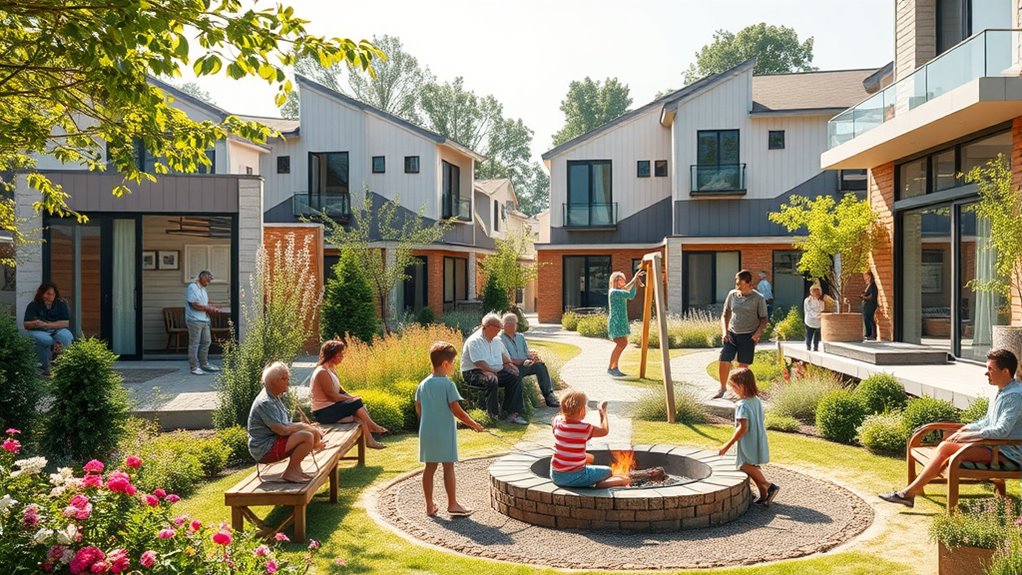
When you live in a co-housing community with extended family, sharing expenses can considerably cut your costs. This arrangement not only makes daily living more affordable but also offers greater financial security for everyone involved. As a result, you can save more and prepare better for the future. Additionally, sharing resources such as electric bikes or other eco-friendly transportation options can further reduce individual expenses and promote sustainable living.
Shared Expenses Reduce Costs
By sharing household expenses, extended families can considerably lower individual costs and make living more affordable. This approach promotes community sustainability by pooling resources and reducing waste, benefiting everyone involved. When expenses like utilities, groceries, and maintenance are divided, each person’s financial burden decreases. This shared financial responsibility encourages cultural adaptation, as family members learn to collaborate and communicate more effectively. Additionally, it allows for better allocation of funds toward communal needs or investments, strengthening the household’s overall stability. Implementing space optimization strategies can further enhance the functionality and comfort of shared living environments. By reducing individual expenses, you create a more economically resilient living environment that supports long-term sustainability and fosters stronger bonds among family members. Ultimately, shared costs make extended family living a practical, cost-effective choice for today’s evolving housing landscape.
Increased Financial Security
Sharing financial responsibilities within an extended family boosts overall economic security by providing a stable income base. When multiple generations pool resources, you guarantee a reduction in the financial strain on individual members, making it easier to cover expenses and plan for the future. Intergenerational bonding strengthens as family members work together, creating a supportive environment. This setup also assures elder care is more accessible and affordable, as caregiving duties are shared among relatives rather than outsourced. With shared financial commitments, you gain resilience against economic uncertainties and unexpected costs. The combined income and resources foster a sense of security, allowing you to invest in long-term stability. Additionally, understanding the importance of spoiled lemon juice can help maintain a healthy environment within the household. Ultimately, co-housing solidifies your family’s financial footing while enhancing emotional bonds across generations.
Environmental Benefits of Shared Living Spaces
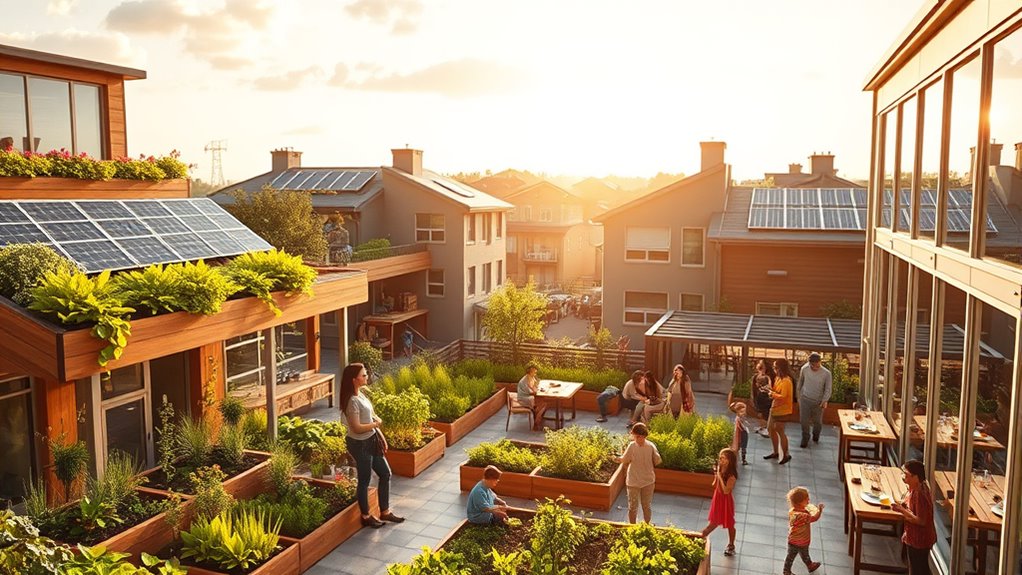
Shared living spaces considerably reduce environmental impact by optimizing resource use and decreasing waste. When you choose co-housing, you contribute to urban sustainability by sharing utilities, reducing energy consumption, and minimizing overall waste. Many co-housing communities incorporate renewable energy sources like solar panels, lowering reliance on fossil fuels. This approach not only cuts carbon emissions but also promotes eco-friendly living habits. Eye patches with beneficial ingredients like collagen and hyaluronic acid can enhance skin hydration and appearance, further supporting sustainable beauty routines.
Social Dynamics and Building Community
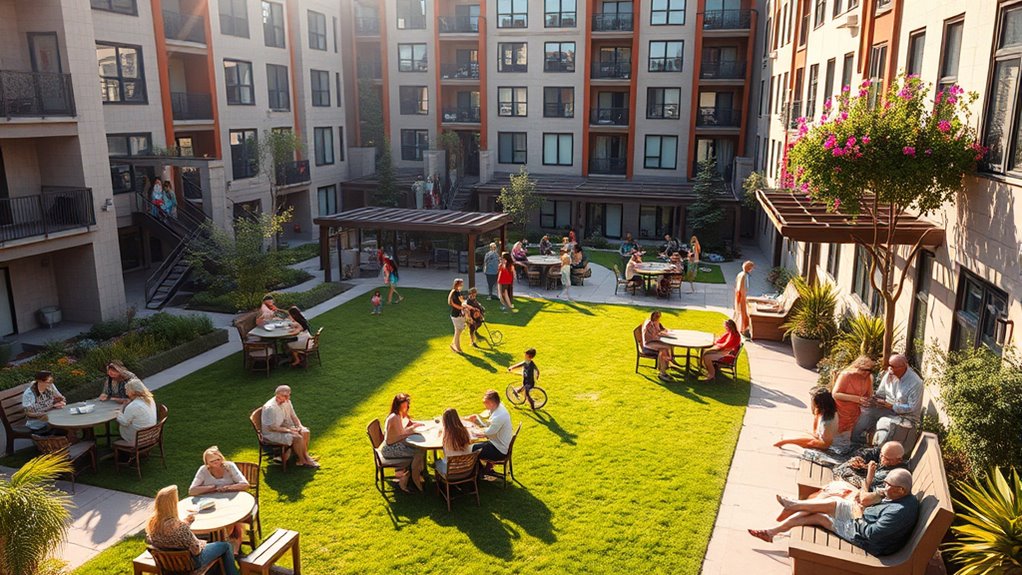
Building a strong community in co-housing relies on shared responsibilities and clear communication. You’ll need to foster respectful interactions and encourage everyone to participate in organizing communal activities. When everyone contributes, it creates a sense of trust and belonging that strengthens your neighborhood. Regularly assessing cost variances can help identify areas where management and participation can be improved, ensuring the community remains financially sustainable.
Shared Responsibilities and Tasks
When residents take on their responsibilities directly, it fosters a sense of collective ownership and strengthens social bonds within the community. Sharing chores and tasks creates a collaborative environment where everyone feels involved and valued. You might participate in shared childcare, reducing individual burdens and fostering trust. Providing caregiver support ensures no one feels overwhelmed and promotes mutual assistance. Clear communication about responsibilities helps prevent misunderstandings and builds accountability. This shared approach encourages residents to support each other in daily routines and unexpected challenges. It also nurtures a culture of respect and cooperation, essential for a thriving co-housing community. Incorporating regular assessment and rotation of tasks can help maintain organization and prevent burnout among residents.
Cultivating Respectful Interactions
Fostering respectful interactions is essential for creating a harmonious co-housing community, as it encourages open communication, empathy, and consideration among residents. You can achieve this by respecting interpersonal boundaries, understanding each person’s needs and limits. When conflicts arise, focus on conflict resolution strategies that promote understanding and find common ground. Listening actively and expressing yourself calmly helps prevent misunderstandings and build trust. Remember, maintaining respectful interactions requires ongoing effort and awareness. By setting clear boundaries and addressing issues promptly, you create an environment where everyone feels valued and safe. This foundation of respect encourages cooperation and strengthens community bonds, making co-housing a sustainable and enriching living experience for all residents. Incorporating conflict resolution strategies can further help maintain harmony and promote mutual understanding within the community.
Organizing Communal Activities
How can you strengthen your co-housing community? Organizing communal activities helps build bonds and foster a sense of belonging. Plan events that encourage interaction, like shared meals or group projects. When arranging interior decoration, keep privacy boundaries in mind so everyone feels comfortable participating. Use shared spaces thoughtfully to promote inclusivity without infringing on personal privacy. Clear communication about activity schedules ensures no one feels overwhelmed or excluded. Consider rotating responsibilities so everyone has a say in planning. Regularly gather feedback to improve activities and address concerns. Staying informed about community building strategies can enhance group cohesion and ensure all residents feel connected and respected. Building a vibrant community requires intentional effort, but it makes co-housing a rewarding, extended family experience.
Challenges and Considerations in Co-Housing Arrangements
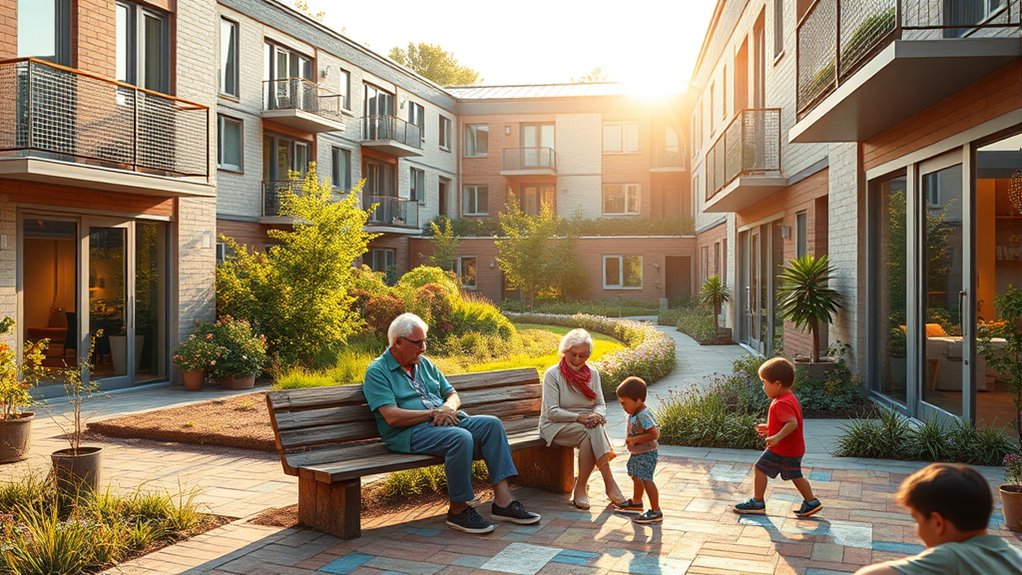
Co-housing offers many benefits, but it also presents unique challenges that potential residents must carefully consider. Privacy concerns are a common issue, as sharing common spaces can feel intrusive if boundaries aren’t clearly defined. Open communication and shared expectations help mitigate these concerns, but it’s essential to be honest about your comfort level. Zoning restrictions can also pose hurdles, as local regulations may limit certain types of communal living or construction modifications. Managing these restrictions requires thorough research and sometimes legal advice. Additionally, balancing individual needs with collective goals demands ongoing effort and compromise. Understanding these challenges beforehand allows you to make informed decisions, ensuring that co-housing becomes a positive, sustainable living experience rather than a source of frustration.
Designing Spaces for Multi-Generational Living
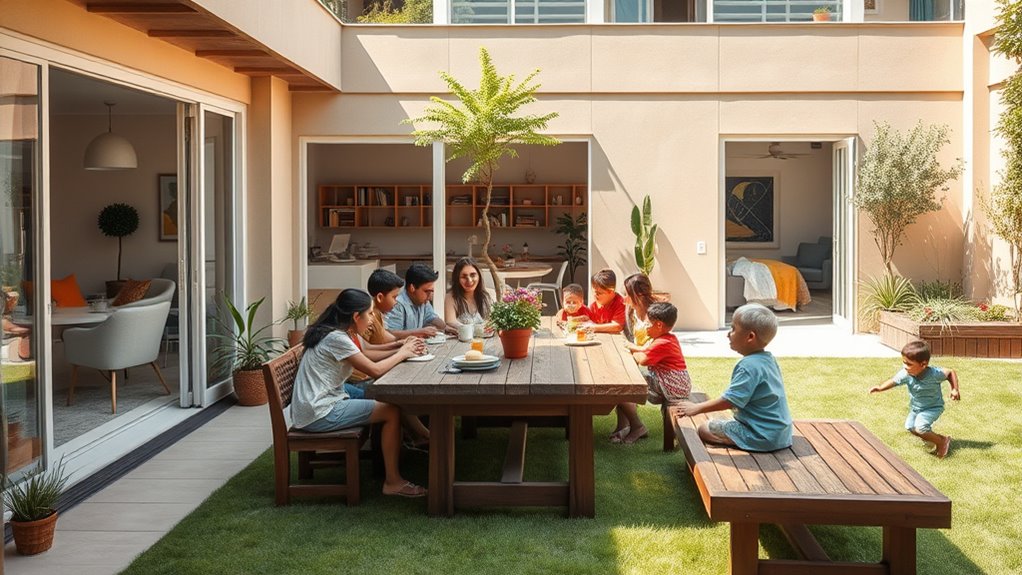
Designing spaces for multi-generational living requires careful planning to guarantee comfort and functionality for residents of all ages. You should focus on creating flexible layouts that accommodate diverse needs. Prioritize interior aesthetics to foster a welcoming atmosphere while maintaining practicality. Incorporate private outdoor spaces for each generation, offering a retreat for relaxation or activities. Think about accessibility features to ensure ease of movement for seniors and children alike. Balance shared areas with private retreats, giving everyone their own space. Consider soundproofing to maintain privacy and reduce noise disturbances. Use natural light and durable materials to enhance comfort and longevity. Ultimately, thoughtful design promotes harmony, making multi-generational living a seamless experience for all involved.
Legal and Regulatory Aspects to Consider
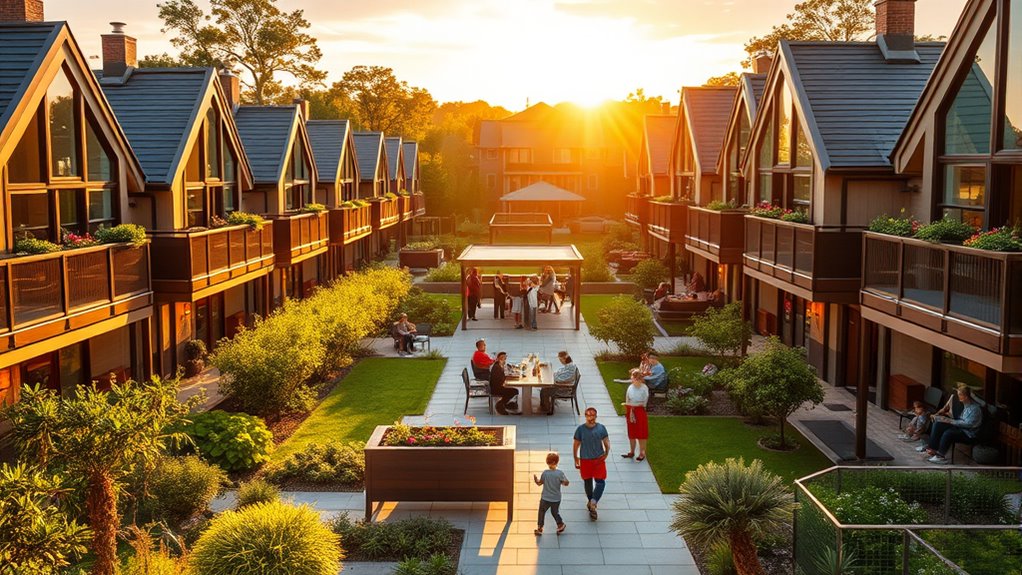
Traversing the legal and regulatory landscape is essential to guarantee your co-housing project complies with all relevant laws and avoids future complications. Zoning regulations play a crucial role, determining where and how you can develop your community. Some areas restrict multi-family or communal living, so you must verify local zoning codes before planning your project. Additionally, understanding property ownership is vital—decide whether you’ll purchase, lease, or create a cooperative ownership structure. Clear legal arrangements help prevent disputes and ensure shared responsibilities are defined. Consulting with legal professionals familiar with housing laws ensures your co-housing setup aligns with local, state, and federal requirements. By addressing these aspects early, you lay a solid foundation for a successful, compliant community.
Successful Examples From Around the World
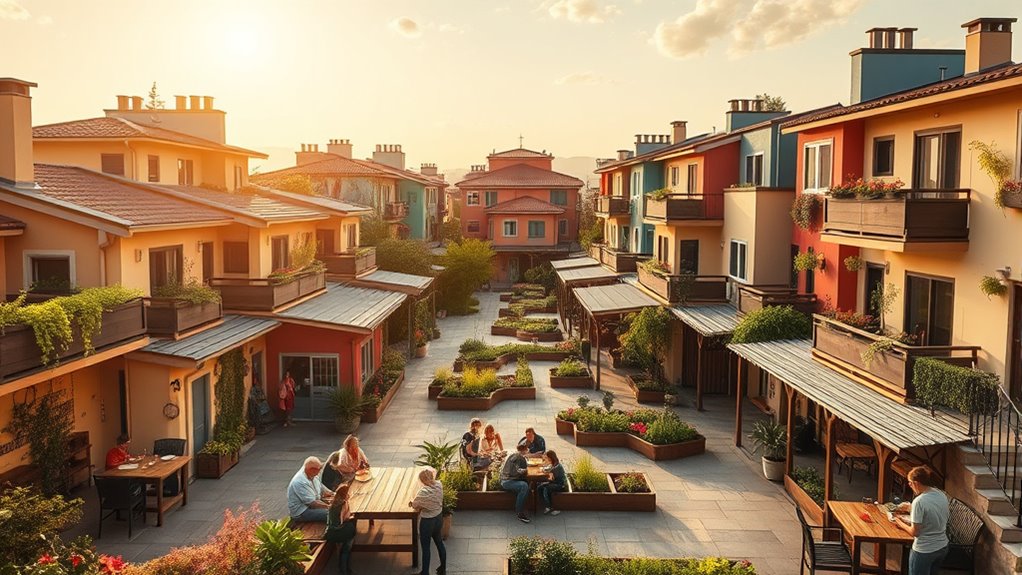
Many successful co-housing communities around the world demonstrate what’s possible when legal and regulatory hurdles are thoughtfully addressed. These examples showcase innovative approaches to urban sustainability and technological innovations that foster connection and efficiency. In Denmark, EFFEKT’s urban cohousing project integrates green spaces and shared resources, reducing environmental impact. In the U.S., the Orcas Island co-housing community leverages smart home technology to enhance energy efficiency and resident interaction. Australia’s Melbourne cohousing initiatives prioritize sustainable building designs and community-driven planning. These models prove that with thoughtful planning, co-housing can promote ecological responsibility and social cohesion. By studying these examples, you see how embracing innovation and sustainability creates thriving, resilient extended family living environments.
The Future Outlook for Co-Housing Models
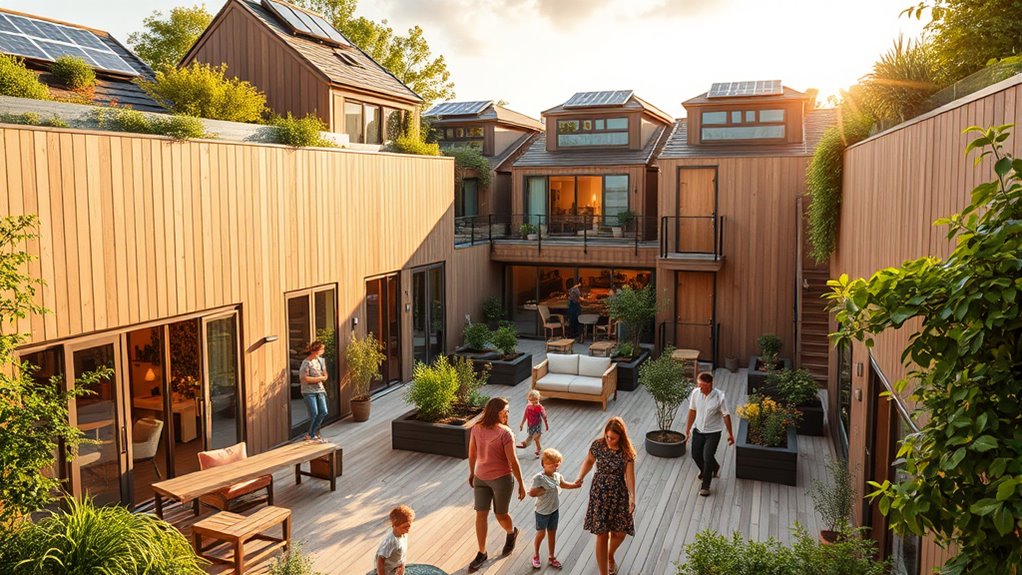
As the global emphasis on sustainability and community resilience grows, co-housing models are poised for a transformative future. You’ll see increased focus on fostering strong intergenerational bonds, which enhance mutual support and shared experiences. These models will likely become more culturally diverse, reflecting the global movement toward inclusion and understanding. As communities embrace sustainability, co-housing will evolve to prioritize eco-friendly designs and shared resources, making them more attractive and practical. You can expect policies and incentives to support these developments, encouraging more people to choose extended family living arrangements. The future of co-housing isn’t just about affordability; it’s about creating vibrant, interconnected communities that celebrate cultural diversity and strengthen intergenerational relationships for lasting societal benefits.
Frequently Asked Questions
How Do Co-Housing Communities Handle Privacy Concerns?
You might wonder how co-housing communities handle privacy concerns. They typically set clear privacy boundaries, giving each household private spaces to retreat. At the same time, they design communal spaces to encourage social interaction without infringing on personal privacy. Residents respect each other’s boundaries, balancing personal privacy with community engagement. This thoughtful setup helps everyone feel secure while enjoying the benefits of shared living.
What Are the Typical Costs Involved in Establishing a Co-Housing Community?
Think of building a co-housing community like planting a garden—you need to prepare the soil first. Typically, you’ll face costs for land, construction, and shared amenities. You’ll also need to weigh legal considerations like zoning and ownership structures. Financial planning is essential to cover these expenses and ongoing maintenance. By understanding these costs upfront, you set the foundation for a thriving community that grows together over time.
How Do Co-Housing Arrangements Address Conflicting Lifestyles?
You find that co-housing arrangements address conflicting lifestyles through shared responsibilities and open communication. By clearly defining roles and expectations, you minimize misunderstandings. When conflicts arise, you engage in conflict resolution strategies like group discussions or mediations. This collaborative approach helps you respect different habits while maintaining harmony, making co-housing a practical solution for diverse lifestyles living together comfortably and cooperatively.
Are There Successful Co-Housing Models for Single-Parent Families?
Ever wondered if single-parent families can thrive in co-housing? You might be surprised to learn that successful models exist, offering shared parenting and community support that ease daily challenges. These arrangements foster a sense of belonging, reduce isolation, and provide practical help. By building strong connections, single parents find a supportive environment where they and their children flourish—turning what seems like a niche into a promising future.
How Scalable Are Co-Housing Communities for Larger Populations?
You wonder how scalable co-housing communities are for larger populations. As population density increases, these communities face infrastructure challenges like transportation, utilities, and shared spaces. To expand successfully, you’d need to adapt designs and resources to support more residents without sacrificing community intimacy or sustainability. While scaling is possible, it requires careful planning to balance growth with infrastructure capacity and maintain the core benefits of co-housing.
Conclusion
So, step into the sustainable, social, and spacious world of co-housing. By blending benefits, building bonds, and breaking barriers, you can create a community where care and connection thrive. Embrace this evolving model to foster families, foster futures, and forge friendships. Co-housing isn’t just a concept; it’s a culture of collaboration, compassion, and community. The future’s flourishing with shared spaces—where you can live, love, and grow together.
